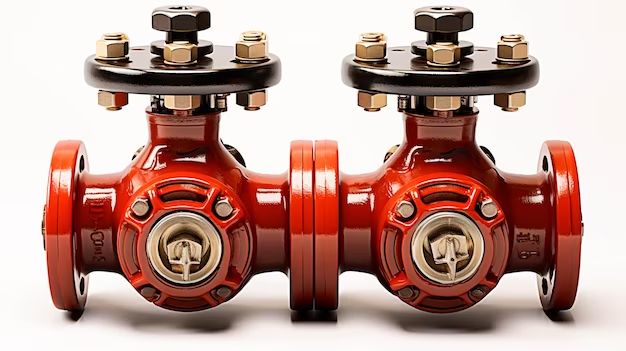Choosing the right type of valve for your application is crucial for proper system operation and maintenance. The two most common types of isolation valves are gate valves and stop valves. But when should you use one versus the other? Here is a detailed comparison of gate valves vs. stop valves to help you select the best option.
Page Contents
What is a Gate Valve?
A gate valve is a linear motion valve used to start or stop fluid flow. It operates by lifting a round or rectangular gate/wedge out of the path of the fluid. When the valve is fully open, the gate is fully removed from the flow path, allowing uninhibited flow. When the valve is closed, the gate is lowered into the flow path, blocking flow through the valve. Gate valves are not suitable for throttling purposes.
Types of Gate Valves
There are several types of gate valves:
- Parallel slide gate valve – The gate moves in a direction parallel to the flow
- Wedge gate valve – The gate moves perpendiculalr to the flow
- Knife gate valve – A specialized gate valve used for slurries or liquids with solids
- Double disk gate valve – Two parallel disks operate together to block flow
Advantages of Gate Valves
- Full bore – When open, gate valves have minimal restriction to flow
- Good shutoff – Gate valves provide complete isolation when closed
- Low pressure drop – The straight-through flow path allows low pressure drop
- Bidirectional flow – Gate valves can handle flow in both directions
- Low maintenance – Gate valves are generally maintenance free
Disadvantages of Gate Valves
- Not for throttling – Due to high flow disturbance, gate valves should not be used for flow control
- Large size required – For full bore flow, the valve must be same size as the pipe
- Not for frequent operation – Due to sliding action, gate valves are not suited for frequent cycling
- Higher cost – Gate valve bodies must withstand pipeline pressures when in the closed position
What is a Stop Valve?
A stop valve, also known as a globe valve, is a flow control valve that regulates fluid flow. Stop valves use a rotating disc to adjust flow. The disk is attached to the valve stem, which raises or lowers the disk. Valve flow rate is proportional to the amount of opening of the disk. Stop valves provide accurate throttling capability.
Types of Stop Valves
There are several types of stop valves:
- Globe valve – Most common type with linear or right-angled pattern
- Needle valve – Small, precise version used to finely control flow
- Pinch valve – Flexible rubber sleeve pinches to restrict flow
- Diaphragm valve – Flexible diaphragm blocks and controls flow
Advantages of Stop Valves
- Good throttling – Stop valves can accurately regulate flow rate
- Bidirectional flow – Suitable for flow going both directions
- Tight shutoff – Disk provides positive shutoff when closed
- Lower pressure drop – Streamlined contours reduce turbulence and pressure loss
Disadvantages of Stop Valves
- Restricted flow – The disk always provides some obstruction to flow
- Seat wear – The disk rubbing on the seat causes eventual wear
- Higher maintenance – Stop valves require reconditioning when worn
- Cavitation damage – High pressure drops can cause cavitation erosion
Gate Valve vs. Stop Valve Comparison
When selecting a valve, it is important to consider the application and the desired valve function. Here is a comparison of gate valves vs. stop valves:
| Factor | Gate Valve | Stop Valve |
|---|---|---|
| Flow control | Only fully open or closed | Accurate throttling ability |
| Pressure drop | Very low when open | Higher due to flow path |
| Shutoff ability | Excellent shutoff | Good shutoff when closed |
| Maintenance | Low maintenance | Seat wears over time |
| Applications | Isolating flow | Regulating flow |
| Cost | Higher cost | Lower cost |
When to Use a Gate Valve
Gate valves are best suited for the following applications:
- On/off service – Gate valves should be used when mainly open or closed
- Isolating flow – They provide tight shutoff when closed
- Low pressure drop – Gate valves cause minimal pressure loss
- Larger sizes – Used when same size as adjoining pipe
- Infrequent operation – Due to sliding gates, not for constant cycling
- Slurries – Knife gate good for services with solids
- Bidirectional flow – Suitable for flow going both directions
Typical Gate Valve Applications
- Main process line shutoff
- Branch line isolation
- Pump isolation
- Liquid service isolation
- Steam line isolation
- Slurry flow control
When to Use a Stop Valve
Stop valves should be used in these types of applications:
- Flow regulation – Provides accurate flow control
- Lower flow – Used when valve is smaller than the pipe
- Frequent operation – Suitable for constant cycling action
- Pressure reduction – Used to lower downstream pressures
- Mixing service – Allows blending of fluids
- Metering flow – Allows precise flow measurement
Typical Stop Valve Applications
- Pump discharge control
- Flow measurement
- Steam trap bypass
- Tank inlet/outlet service
- Pressure reducing stations
- Sampling connections
Conclusion
Gate valves are best suited for on/off applications where tight shutoff and low pressure drop are needed. Stop valves are designed for throttling flow control in systems that require accurate metering and frequent operation. Considering the requirements of your application in terms of flow control, pressure parameters, line sizes, and operation frequency will guide you towards selecting either a gate valve or stop valve. Consult manufacturers to pick the best valve design and materials of construction for your particular installation.
